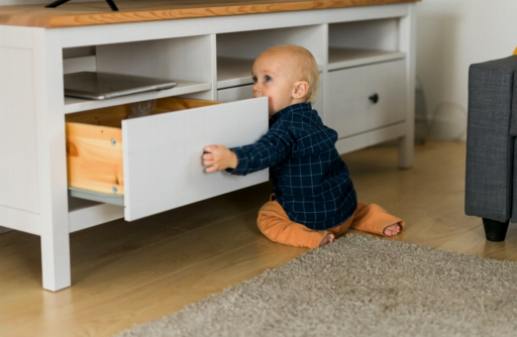Fire Extinguisher Basics: Keeping Your Baby's Environment Safe
22 October 2025 by Jak B.As a new parent, keeping your baby's environment safe is a top priority. One crucial aspect of baby-proofing your home is being prepared for potential fire hazards. Understanding the different types and classes of fire extinguishers, choosing the right one for your home, and knowing how to properly maintain and use it are essential skills for ensuring the safety of your family. In this article, we will cover everything you need to know about fire extinguisher basics and how to keep your baby's environment safe from potential fire risks.

Understanding Fire Extinguisher Types and Classes
Fire extinguishers are an essential safety tool to have in any home, especially for new parents. Understanding the different types and classes of fire extinguishers is crucial in order to ensure the safety of your baby and toddler. By familiarizing yourself with the various types and classes, you can effectively choose the right fire extinguisher for your home and be prepared to respond to any potential fire emergencies.Choosing the Right Fire Extinguisher for Your Home
When it comes to choosing the right fire extinguisher for your home, there are a few important factors to keep in mind. First and foremost, it’s crucial to select a fire extinguisher that is designed for use on common household fires, such as those caused by flammable liquids, wood, paper, and electrical equipment. Look for a multi-purpose extinguisher that is labeled as ABC, which indicates that it can tackle these various types of fires. Additionally, consider the size and weight of the extinguisher – you’ll want one that is manageable for all members of your household to use, but also large enough to provide an adequate amount of extinguishing agent. Finally, be sure to purchase your fire extinguisher from a reputable supplier and check that it is fully charged and has a visible pressure gauge before bringing it into your home.Proper Placement and Accessibility of Fire Extinguishers
It is important to have a fire extinguisher in every major area of your home, including the kitchen, bedrooms, and living room. Make sure the fire extinguishers are easily accessible and not blocked by any furniture or other objects. Keep them at a height where they can be reached quickly, but out of reach of small children. It is also a good idea to have a fire extinguisher in the garage and near the outdoor grill. Having fire extinguishers readily available can help you act quickly in the event of a fire and prevent it from spreading.Fire Extinguisher Maintenance and Inspection Tips
Here are some tips to help you keep your fire extinguishers in good shape:1. Regular Inspections: Check your fire extinguishers at least once a month to ensure they are fully charged and not damaged. Look for any signs of wear and tear, such as dents, rust, or leaks.
2. Annual Maintenance: Have a professional inspect your fire extinguishers at least once a year to ensure they are in compliance with local regulations and are functioning properly. They may also need to be recharged or replaced if they are not up to standard.
3. Proper Storage: Store your fire extinguishers in an easily accessible and visible location, away from heat sources and high traffic areas. They should also be mounted at the correct height, and secured in place to prevent them from falling or being knocked over.
4. Training and Education: Ensure that all family members are familiar with the location of the fire extinguishers in your home, as well as how to properly use them in case of a fire. Consider providing training on how to operate a fire extinguisher, and review the instructions regularly. By following these maintenance and inspection tips, you can help to ensure that your fire extinguishers are ready to use in the event of a fire, and provide a safe environment for your baby or toddler.
How to Use a Fire Extinguisher: Step-by-Step Guide
Using a Fire Extinguisher: Step-by-Step Guide In the event of a fire, it is important to know how to properly use a fire extinguisher to quickly and effectively put out the flames. Here is a step-by-step guide for using a fire extinguisher:1. Pull the Pin: The first step is to pull the pin located at the top of the fire extinguisher. This will break the tamper seal and allow you to discharge the extinguisher.
2. Aim at the Base: When using the fire extinguisher, it is important to aim at the base of the flames, not at the top of the fire. This is where the source of the fire is located, and targeting the base will help to smother the flames.
3. Squeeze the Handle: Next, squeeze the handle or lever of the fire extinguisher. This will release the extinguishing agent, such as powder, foam, or water, onto the fire.
4. Sweep Side to Side: While squeezing the handle, sweep the extinguishing agent from side to side, covering the entire area of the fire. This will help to ensure that all of the flames are fully extinguished.
5. Watch for Re-ignition: After using the fire extinguisher, it is important to watch for any signs of re-ignition. If the fire starts to flare up again, you may need to use the extinguisher a second time or evacuate the area. It is crucial to remember that fire extinguishers are only effective for small fires. If the fire has spread or is too large to be controlled with an extinguisher, it is important to evacuate the area immediately and call the fire department. By familiarizing yourself with the step-by-step guide for using a fire extinguisher, you can help to ensure the safety of your baby and family in the event of a fire emergency.